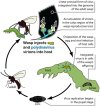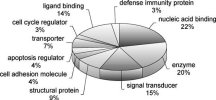@Pierre there is possibly an error in the sentence above: the E-O boundary is dated 37 Mya.So, while iridium anomalies at the E-O boundary signal that the mass extinction about 66 million years ago was due to a cosmic event, it remained to be seen whether the culprit was a supernova or a meteor bombardment.
You are using an out of date browser. It may not display this or other websites correctly.
You should upgrade or use an alternative browser.
You should upgrade or use an alternative browser.
Mass Extinctions, Evolutionary Leaps, and the Virus-Information Connection
- Thread starter Pierre
- Start date
good catch! Yes it is a mistake. It is now corrected.@Pierre there is possibly an error in the sentence above: the E-O boundary is dated 37 Mya.
Stella Marys
Jedi Master
THANK YOU Pierre for your generosity! Before I continue reading the material, I wanted to pass on my thanks to you.
On the other hand, is it possible that you could show us how is your gesture representing the information field? Apparently, you have a trademark.
I ask this, because every time the words "information field" appear in a conversation, I automatically guess what could be the gesture that represents this concept, but it is just a guess. Non-verbal language is also important to illustrate an idea, it can even enhance it in many cases.
Well, again THANK YOU for sharing your monumental effort with us! It is very, very much appreciated!
On the other hand, is it possible that you could show us how is your gesture representing the information field? Apparently, you have a trademark.

I ask this, because every time the words "information field" appear in a conversation, I automatically guess what could be the gesture that represents this concept, but it is just a guess. Non-verbal language is also important to illustrate an idea, it can even enhance it in many cases.
Well, again THANK YOU for sharing your monumental effort with us! It is very, very much appreciated!

It should be Chicxulub.the Chixulub impact crater ca. 66 Mya (3 cycles ago) coincident with the end Cretaceous (or K/T) extinction
There is no black arrow on the graph below.This hypothesis was considerably strengthened in 2021 when Rampino[34] demonstrated that during last 260 My the last 89 major geological events, including cometary bombardments, mass volcanism, anoxia and sea level change and mass earthquakes where in sync with the 27-My cycle, as illustrated by the diagram below, which shows on the left the timing of major geological events (smoothed) while the graph on the right reveals the 27.5-My cyclicity of these major geological events as indicated by the black arrow:
@Pierre Some more:
258 Mya -> 358 Mya
See here.
From Wikipedia:
-> "and Alvarez"
Hangelberg -> HangenbergThe Hangelberg Event (ca. 258 Mya) part the late Devonian extinction
258 Mya -> 358 Mya
See here.
-> 372 MyaThe Kellwasser Event (ca. 272 Mya)
From Wikipedia:
refers to a major extinction, the Kellwasser event (also known as the Frasnian-Famennian extinction), which occurred around 372 million years ago
Corrected in the main file and in the postIt should be Chicxulub.
It was not the correct graph. Good catch. It is corrected now in the main file and in the post.There is no black arrow on the graph below.
Last edited:
Interesting!! If we have so many viruses around us and inside out bodies right down to the DNA then we ought not to call them "viruses". They are more like self-aware consciousness units connected with the Information field. Not only do they help create and evolve life, in turn assisting in soul development but, on the other hand they also help in body-death via "diseases" when the soul is not making the best use of it.
very nice summary!Interesting!! If we have so many viruses around us and inside out bodies right down to the DNA then we ought not to call them "viruses". They are more like self-aware consciousness units connected with the Information field. Not only do they help create and evolve life, in turn assisting in soul development but, on the other hand they also help in body-death via "diseases" when the soul is not making the best use of it.
Chapter 14: Beneficial Viruses
Exogenous viruses
The evolutionary role played by viruses is huge compared to their pathogenicity. Out of the estimated 100 million different species of viruses mentioned in the previous chapter, only about 200[1], in other terms a mere 0.0002%, might cause diseases in humans.
These 200 viruses are only sometimes pathogenic, most carriers are asymptomatic. On top of that, some of these 200 documented viral “pathogens” can also induce beneficial effects; it’s for example the case of the widespread Herpes virus and cytomegalovirus.
Indeed, both Herpes virus and cytomegalovirus exhibits either detrimental or beneficial effects depending on the state of the host’s immune system:
Herpesviruses, such as herpes simplex virus and cytomegalovirus are well-known examples of the virome that are prevalent in greater than 50% and up to 90% of the human population, respectively. While these viruses can become pathogenic during states of immune suppression, they may provide beneficial immunologic stimuli to the host at steady state [2]
Herpesvirus and cytomegaloviruses are not isolated cases. A virus as common as the flu, believed until recently to be solely a pathogenic agent, is now known to be beneficial by making people more sociable[3]. Notice some subjects in this study had the pro-social benefit of the virus without experiencing any symptoms.
The benefits of viruses are numerous, for example, they enhance the protection of their hosts against bacterial infections[4], they help alternative routes of carbon metabolism during infection[5] and they stimulate the creation of heat shock proteins[6] (HSPs) during times of stress[7]. HSPs are involved in processes as fundamental as:
HSPs are important factors in regulating cell survival, differentiation and cell death. Accumulating evidence shows that some HSPs participate in not only innate cellular immunity but also antigen presentation in adaptive immune response. HSPs also serve as potential biomarkers for some diseases.[8]
An even stunning example virus-host synergy comes from parasitic wasps have domesticated viruses that cannot replicate outside the wasps. When injected inside a prey, the viruses neutralized the host’s immune system, so it doesn’t attack the eggs laid by the wasp inside the body of the host:
Wasps inject PDVs [Polydnaviruses] into hosts during parasitism, which then express viral gene products that alter host immune defenses, growth and development to optimize conditions for development of the wasp’s offspring.[9]
But maybe the best example of the health benefits induced by viruses is the use of bacteriophages in the treatment of bacterial diseases:
[d’Herelle and] Georgi Eliava established phage therapy in Tsiblisi at the Eliava Institute in 1936, which still exists until this very day. Up to 1200 employees were producing tons of phages in peak times. They produced pills, band aids, and treated 18.000 soldiers in the Finnish-Russian War in 1939 with a phage cocktail against anthrax with 80 % success rate, which means avoiding amputations. In 1963 as many as 30.000 children were treated some even with phage as a prophylactic[10]
For reference, untreated inhalation anthrax has a fatality rate of 80% or higher[11].
The examples above show how prevalent and vital viruses are in animal life forms, including humans. But the same goes for plants:
viruses generally have not been included in the beneficial microbe lists. Recent work has indicated that they can also play important and beneficial roles in plants.[12]
One of the main purposes of viruses used by botanists is to improve the beauty of a given plant:
Some of the best characterized beneficial viruses that have been used in plants are those that enhance the beauty of ornamental plants. Tulip breaking virus was the first of a long list of the beautiful viruses, but many other prized ornamentals owe their value, at least in part, to the viruses that infect them[13]

© Norton Simon Museum
Gouache before 1640 - effect of Tulip breaking virus: streaks of white in its red petals
But the beneficial role played by viruses in plants goes way beyond esthetics:
[viruses] are involved in conferring tolerance to drought, cold and hot soil temperatures […] increases their value or growth potential, or decreases the need for the use of chemical fertilizers or pesticides.[14]
Like in the human genome, viruses have been present in plants genome for a long time:
Studies on virus biodiversity are indicating that plants are infected with numerous viruses that do not have any apparent ill effects on their hosts […] These viruses have very long relationships with their plant hosts, being vertically transmitted for perhaps thousands of years, strongly implying a positive interaction.[15]
Endoretroviruses
Although the list of benefit provided by exogenous viruses to their hosts is substantial, it is nothing compared to ERVs.
We’ve seen previously the pivotal role played by ERVs in the apparition of a number of new complex taxa: wallabies, humans, great apes, vertebrates, eukaryotes, jawed vertebrates, teleost fishes Lepidoptera and of course placentals.[16]
For the latter we’ve seen how ERVs were the driver of the apparition of the placentals, including virtually all mammals. Before that reproductive strategies were based on egg-laying.
Like most exogenous viruses, ERVs don’t cause diseases:
Most ERV sequences have acquired numerous mutations over time and therefore do not have protein-coding potential or the potential to generate infectious viral particles.[17]
But the fact that the numerous viral sequences found in our DNA are not pathogenic doesn’t mean that they are useless archaism. Actually their integration of ERVs in the host’s genome provides benefits:
HERVs thus appear to contain still active genes, which most probably have been subverted by the host for its benefit and should be considered as bona fide human genes.[18]
ERVs are part of what was called “junk DNA”[19], which, for decades, was considered as useless DNA stored away during “evolutionary selection”. This kind of DNA represents about 90%[20] of our genome. But it is now called non-coding DNA because modern genomic has revealed that the junk DNA is not junk at all. One prime example is “gene desert”:
Gene deserts are regions of the genome that are devoid of protein-coding genes […] Originally believed to contain “junk” DNA due to their inability to create proteins, gene deserts have since been linked to several vital regulatory functions, including distal enhancing and conservatory inheritance. Thus, an increasing number of risks that lead to several major diseases, including a handful of cancers, have been attributed to irregularities found in gene deserts. [21]
In addition, the common belief that ERVs are non-coding is generally true, but yet there are exceptions for example HERV-K[22] is known to code HDTV[23].
Out of 500 env genes[24], 16 can code for proteins and are abundantly transcribed in key organs like the brain, the thyroid or the adrenal:

© de Parseval
Transcriptome of the coding retroviral envelope genes of the human genome in 19 human tissues
In addition to directing genes expression, ERVs have an uncanny ability to modify the existing genome of their hosts, viral and non-viral sequences included:
A detailed study of the HERV‑K (HML2) subfamily shows that 6 (17%) of the 35 full-length copies examined have undergone some form of NAHR [a kind of recombination] following insertion, despite their fairly recent origin (<20 million years ago). Given that this subfamily accounts for a minuscule fraction (<<1%) of human ERVs, these data underscore the potentially profound contribution of ERVs to remodeling genome architecture over a large timescale.[36]
Despite the recent advent of genomics, there are already numerous examples of beneficial effects induced by endogenous viruses, for example ERVs play a fundamental role in protecting their hosts from ongoing epidemics:
[ERVs] support the antiviral immune response via numerous mechanisms. These include the enhancement of cellular sensing pathways, regulation of viral gene expression, blockade of entry receptors, and direct restriction of virion assembly.[25]
Another example of beneficial effect induced by ERVs is their involvement in the regulation of the expression of useful coding genes:
"In 1996, Roy J Britten, of the California Institute of Technology, was able to list ten examples in which endogenous retroviral sequences helped regulate the expression of a useful gene. Seven of the ten examples were human.[26]
ERVs are involved in the detection and fight against cancer:
Cytotoxic T cells and natural killer cells are important effectors of tumor surveillance. They are armed with granzyme and perforin to directly kill tumor cells. A recent study using a set of 66 ERVs as a reference showed that 8 of the 66 ERVs positively correlated with the expression of granzyme and perforin in breast cancer tissues, implying a potential role of ERVs in immune surveillance[27]
And ERVs are also necessary for embryo development from the earliest stage:
"[...] when Corrado Spadafora […], applied an anti-reverse transcriptase drug in this very early stage of embryogenesis in the mouse, all development ceased at the four-cell stage. It would appear that endogenous retroviruses are playing a very profound, if completely unknown, role at this early stage in mammalian embryogenesis. [28]
Maybe the fundamental role played by ERVs in morphogenesis as emphasized in the quote above explains why viruses played also a pivotal role in what can be consider as the greatest evolutionary leap, namely the transition from unicellular organisms to multicellular ones:
All known cell fusion molecules are viral in origin suggests that they have been vitally important to the inter-cellular communication systems that enabled multicellularity. Without the ability of cellular fusion, colonies could have formed, but anything even as complex as a sponge would not have been possible.[29]
The above shows the prevalence of viruses in our genetic code and the vital role they play. This perspective provides a different spin to the on-going question about whether viruses are life forms or not. The answer to this question amply depends on the definition one gives to the word “life”.
Virus contributed to human genome and bring beneficial changes bacteria and viruses have donated to the eukaryotic genome many of the core genes which made evolution and speciation possible (Joseph 2009a,b), whereas viruses often provide substantial benefits to the host and are often subverted by the host for its benefit (Lorenc and Makalowski. 2003; Miller et al., 1999; Parseval and Heidmann 2005). Thus, viruses do not generally sicken the host, but provide benefits to the host. Moreover, they insert genes and regulatory elements into the host genome and have played an active role in evolution leading to humans (Joseph 2009a,b).[30]
In the light of the quote above, viruses seem more fundamental than even life itself; they are the information carriers -genetic codes- from which biological life stems. Viruses are more than life; they are the very source of life; they are the informational precursors, the initiators of every single lifeform:
As we can see by the above description of the virome[31], it is no exaggeration to say that the virome is the language of all life on earth. We are literally swimming in a vast sea of genomic information that was essential for life to begin and flourish on this precious earth and that is still trying to help all species survive. The matrix of organisms that make up the microbiome have built a viromic information stream that has allowed for adaptation and biodiversity to occur on the planet. And that very same viromic information stream is responsible for building the human species.[32]
ERVs are involved in a multitude of fundamental functions amongst which, altering and promoting amylase gene, expressing host genes or to facilitating splicing events:
Among endogenous retroelements that retain some degree of function, many have adapted and have become symbionts in their host species. […] ERVs co-evolving with their hosts include the contribution of an ERV enhancer in altering the tissue specificity of a human amylase gene[33] from pancreatic to parotid-specific expression, promoting salivary gland-specific regulation of this gene. ERV promoters have been employed by their hosts as promoters to express host genes, or to facilitate specific splicing events[34]
Another example is how transposable elements (sequences of viral origin) are involved in a number of vital processes from immunity to apoptosis (cellular death) regulation[35]:
[1] The exact number of potentially pathogenic virus in human in exactly 219 as of 2012. Notice also that, on average, 3 to 4 potentially pathogenic viruses in human are discovered every year. See:
Woolhouse, Mark et al. (2012). “Human viruses: discovery and emergence.” Philosophical transactions of the Royal Society of London. Series B, Biological sciences vol. 367,1604 (2012): 2864-71.
[2] Tokuyama, Maria et al. (2018). “ERVmap analysis reveals genome-wide transcription of human endogenous retroviruses”. PNAS, 115 (50) 12565-12572;
[3] Reiber C. et al. (2010) “Change in human social behavior in response to a common vaccine”. Ann Epidemiol. 20(10):729-33.
[4] Sherman LA, Pauw P. (1976) “Infection of Synechococcus cedrorum by the cyanophage AS-1M. II. Protein and DNA synthesis”. Virology.;71(1):17-27
[5] Sullivan MB et al. (2005) “Three Prochlorococcus Cyanophage Genomes: Signature Features and Ecological Interpretations” PLOS Biology 3(5): e144
[6] Key proteins involved in proteins folding, transport and assembly. HSP’s are also involved in apoptosis and immune response.
[7] Wan, Q. et al. (2020). “Stress proteins: the biological functions in virus infection, present and challenges for target-based antiviral drug development”. Sig Transduct Target 5, 125
[8] Ibid
[9] Burke, G. R. et al. (2012). ‘’Polydnaviruses of Parasitic Wasps: Domestication of Viruses To Act as Gene Delivery Vectors’’. Insects, 3(1), 91–119.
[10] K. Moelling (2020) “Viruses More Friends than Foes” Electroanalysis 32, 669.
[11] FDA Editors (2018) “anthrax” FDA
[12] Roossinck, M.J. (2015) “Beneficial viruses for crops” Molecular Plant Pathology 16: 331-333.
[13] Ibid
[14] Ibid
[15] Roossinck, M.J. (2012) “Plant virus metagenomics: biodiversity and ecology” Annu. Rev. Genet. 46, 357–367
[16] See chapter ‘’The Enigma of Speciation’’
[17] Tokuyama, Maria et al. (2018) “ERVmap analysis reveals genome-wide transcription of human endogenous retroviruses”. PNAS, 115 (50) 12565-12572
[18] de Parseval N. et al. (2005) “Human endogenous retroviruses: from infectious elements to human genes”. Cytogenet Genome Res. 110(1-4):318-32
[19] TR, ed. (2005) “The Evolution of the Genome” Elsevier. pp. 29–31
[20] Ponting, C.P. (2011) "What fraction of the human genome is functional?" Genome Research. 21 (11): 1769–76
[21] Ovcharenko, Ivan et al. (2004) "Evolution and Functional Classification of Vertebrate Gene Deserts" Genome Research 15 (1): 137–145
[22] Boller K. et al. (1993) “Evidence that HERV-K is the endogenous retrovirus sequence that codes for the human teratocarcinoma-derived retrovirus HTDV”.Virology. 196(1):349-53
[23] Human Teratocarcinoma-Derived Virus particles
[24] Genes of viral origin
[25] Srinivasachar Badarinarayan S., Sauter D. (2021) “Switching Sides: How Endogenous Retroviruses Protect Us from Viral Infections” J Virol. 95(12):e02299-20
[26] Ibid
[27] Tokuyama M et al. (2018) “ERVmap analysis reveals genome-wide transcription of human endogenous retroviruses”. PNAS 115:12565–72
[28] Ibid
[29] Wikipedia contributors (2021) “Multicellular organism” Wikipedia
[30] Wickramasinghe, 2013
[31] Assemblage of viruses that are associated with a particular ecosystem
[32] David Skripac (2021) “Our Species is Being Genetically Modified: Humanity’s March Toward Extinction?” Global Research
[33] Enzyme that transforms starch into sugars
[34] Eiden M. V. (2008) “Endogenous retroviruses--aiding and abetting genomic plasticity” Cellular and molecular life sciences 65(21), 3325–3328
[35] Lorenc, Anna et al. (2003) “Transposable Elements and Vertebrate Protein Diversity” Genetica 118. 183-91. 10.1023
[36] Feschotte, C., Gilbert, C. (2012) “Endogenous viruses: insights into viral evolution and impact on host biology” Nat Rev Genet 13, 283–296
Last edited:



